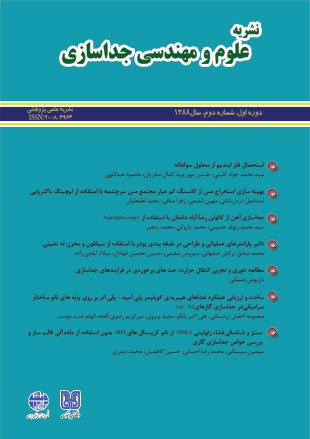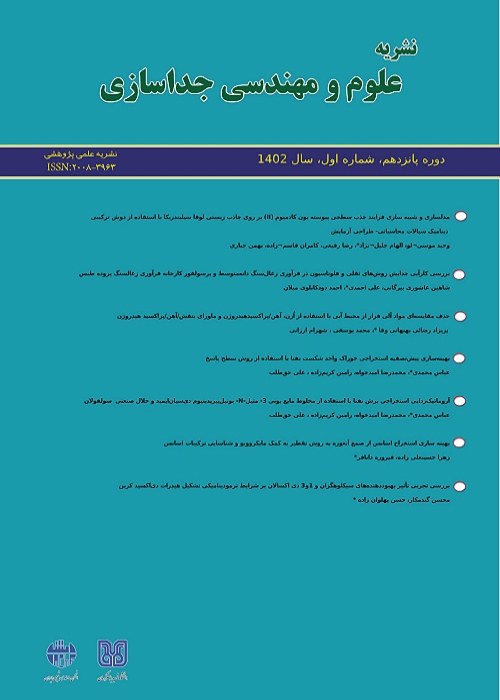فهرست مطالب

نشریه علوم و مهندسی جداسازی
پیاپی 2 (پاییز و زمستان 1388)
- تاریخ انتشار: 1389/05/10
- تعداد عناوین: 7
-
-
Page 1In this study, the solvent extraction and cementation processes for the recovery of indium from sulfate solution have been studied. In the extracting step from sulfate solution, optimum values of effective parameters including, pH of aqueous solution, time of contact between phases, D2EHPA concentration in organic phase and volume ratio of aqueous phase to organic phase were obtained 0.8, 5 min, 30%W D2EHPA in organic phase and 3, respectively. In stripping stage, Sulfuric acid was used as the striping agent and optimum values of effective parameters were obtained 5 M sulfuric acid, time of 5 min and O/A=4. Cementation of indium from stripping solution was performed using zinc powder. Optimum values of effective parameters including powder quantity 2 times to stoichiometric quantity of indium, temperature of 25 °C, pH of solution 3 and time of reaction 6h were obtained. Under optimum conditions, indium recovery of at least 90% was achieved.
-
Page 15It is well-known that the rate of chemical leaching of copper sulfides in limited. So, the important question is whether a mixture of Fe-S oxidizing bacteria can be used to increase the copper recovery from this part of ore and what are the optimum conditions? Therefore, this study is aimed at studying the influence of important parameters such as pH, Fe+2 and Fe+3 concentration and to determine the optimum operating conditions for increasing copper recovery from Sarcheshmeh low grade heap 3 ore. Using Taguchi method design, shake flask tests were designed and performed in addition to column tests. From the results of these experiments it can be pointed out that copper recovery can be increased to about 90% under optimum condition. Compared to the results of chemical leaching, copper recovery by mixed mesophiles is increased about 30% and that by moderate thermophiles about 40%.
-
Page 33Kaolin is a clay mineral that has many industrial applications because of its special characteristics. One of the most important characteristic of this material is its whiteness and brightness. There are a lot of kaolin deposits in Iran that do not have appropriate brightness because of the presence of iron oxides in the ore. In this study, bioleaching of iron oxides by Aspergillus niger NCIM548 was applied to remove impurities from kaolin, and a model was presented to predict the extent of iron removal by this strain. Final results showed the removal of 2.2% of the total iron contents from kaolin that is promising for continuing studies in optimal conditions, and by using other strains of this fungus.
-
Page 41Solid handling by air inside pipeline is called pneumatic conveying. In solid handling the velocity of air is the vital parameter. In this project dilute phase with air velocity of about 10 m/s was used. Powder materials were injected to the pipeline from a bin by a rotary valve and were classified by cyclone. Classifiers depending on their design, operational parameters such as air velocity and powder properties can separate a vast range of powders with respect to their size. After injecting to the pipe, materials are fed to the gravity settling chamber. In this project the objective was to separate powder particles larger than 74 Zm. The experiments were carried out for talc and kaolin and the effect of parameters on separation efficiency were investigated.
-
Page 55In this research, heat transfer of impinging jets in separation processes was studied theoretically and experimentally. The experimental set up was similar to that applied in industry. The system consisted of a cylindrical furnace equipped with an electrical coil which was cooled with six circular coils each connected to eight 3 mm diameter nozzles with a 2.5 cm interval from the wall. The experiments were carried out in two different Reynolds numbers 13500 and 27000 using 7.5 to 14 kW power. The geometry of the system and experimental design was similar to a multiple impinging jets on a curved surface. The studies showed that due to the distances between jets, nozzle to furnace diameter ratio, and distance of the jet from the wall to furnace diameter ratio, the direct effects of jets on each other and curvature of the impact surface on heat transfer could be neglected and the system could be assumed as a set of single set on a flat plate. The results also showed considerable effects of the outlet flow location on the temperature distribution. Another important parameter which was defined for the first time in this work was the dimensionless length from the impact zone which has considerable effect on the temperature profile.
-
Page 67In this work, polyamid-polyether block copolymer (PEBA) was synthesized as a selective top layer of nanostructure ceramic supports and their performance on separation of polar (CO2) and non-polar (N2) gases were evaluated. The effects of several parameters such as polymer solution concentration and number of coated layers on the performance of prepared compositemembranes were investigated. PEBA/ceramic nanocomposite membranes were fabricated by dip-coating of ceramic nanocomposite porous support in 3, 10 and 30 wt. % of copolymer solutions with different dip-coating steps. Chemical and morphological studies on the synthesized copolymer and hybrid membranes were carried out by FT-IR spectroscopy, Atomic force microscopy (AFM), scanning electron microscopy (SEM) and optical microscopy (OM). The results showed that hybrid membranes with 30 wt. % of copolymer solution with 4 dip-coating steps had better performance in the separation of CO2 and N2 processes.
-
Page 79
In this article, MFI nanocrystals have been synthesized in two crystal sizes by two stage varying temperature synthesis procedure using reflux and microwave-assisted hydrothermal method. S-Alumina tubular support was seeded with MFI nanocrystals and ZSM-5 zeolite membrane synthesized on it by secondary growth synthesis technique. Characterization of the membrane by using scanning electron microscopy (SEM) confirmed formation of monotonous zeolite film. The results of X-ray diffraction (XRD) asserted ZSM-5 crystalline structure in this membrane. Four different gases including H2, CO, N2, CH4 were used for investigation of permeation process through the synthesized membrane. The effect of pressure and temperature on permeability and selectivity was investigated. The best permeance result was obtained wa 2.58× 10-8 mol/ (m2.s.Pa) for H2 at 298 K and 1.2 bar feed pressure.


